

Search Soft on SuggestSoft.com - Systems Thinking Software. Five Phases "Strategic Thinking" OR "Systems Thinking" Framework. Jonathan Gabbai — Emergent Systems, Management and Aerospace topics. 'Strategic & Systems Thinking', on January 24 & 25, 2011. The Buckminster Fuller Institute. Homepage. Living Earth Simulator will simulate the entire world. Described as a “knowledge collider,” and now with a pledge of one billion euros from the European Union, the Living Earth Simulator is a new big data and supercomputing project that will attempt to uncover the underlying sociological and psychological laws that underpin human civilization.

In the same way that CERN’s Large Hadron Collider smashes together protons to see what happens, the Living Earth Simulator (LES) will gather knowledge from a Planetary Nervous System (PNS — yes, really) to try to predict societal fluctuations such as political unrest, economic bubbles, disease epidemics, and so on. The scale of the LES, when it’s complete, will be huge. It is hoped that supercomputing centers all over the world will chip in with CPU time, and data will be corralled from existing projects and a new Global Participatory Platform, which is basically open data on a worldwide scale.
Papers. Peter Senge. Peter Michael Senge (born 1947) is an American systems scientist who is a senior lecturer at the MIT Sloan School of Management, co-faculty at the New England Complex Systems Institute, and the founder of the Society for Organizational Learning.
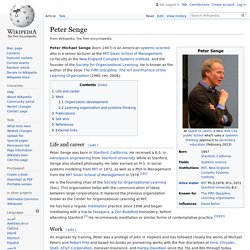
He is known as the author of the book The Fifth Discipline: The Art and Practice of the Learning Organization (1990, rev. 2006). Life and career[edit] Peter Senge was born in Stanford, California. He received a B.S. in Aerospace engineering from Stanford University. While at Stanford, Senge also studied philosophy. He is the founding chair of the Society for Organizational Learning (SoL). He has had a regular meditation practice since 1996 and began meditating with a trip to Tassajara, a Zen Buddhist monastery, before attending Stanford.[3] He recommends meditation or similar forms of contemplative practice.[3][4][5] Work[edit] An engineer by training, Peter was a protégé of John H. Organization development[edit] Publications[edit] See also[edit] Changing the Financial and Insurance Structure in Each State. About E:CO. PlanningProcess. Strategic Planning The Planning Process.
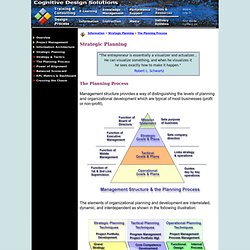
Capital Planning Decision Process. Cynefin-framework-2010-from-baomans-blog- simple complex. List of systems engineering universities. This list of systems engineering at universities gives an overview of the different forms of systems engineering (SE) programs, faculties, and institutes at universities worldwide.

Since there is no clear consensus on what constitutes a systems engineering degree, this list simply identifies the college and department offering degrees and the degrees offered. Education in systems engineering is often observed to be an extension to the regular engineering courses,[1] reflecting the industry attitude that engineering professionals need a foundational background in one of the traditional engineering disciplines (e.g. civil engineering, electrical engineering, industrial engineering) plus professional, real-world experience to be effective as systems engineers.
Undergraduate university programs in systems engineering are rare. The study of Systems. Systems Thinking Systems thinking is used to address complex problems and designs. It can be applied in any discipline or practice. Its origins can be traced back 2,500 years at least, to the ancient Greek philosophers. It is different from but complementary to other ways of thinking like for example scientific reductionism. “Systems thinking is a framework for seeing interrelationships rather than things, for seeing patterns rather than static snapshots .it is a set of general principles spanning fields as divers as physical and social sciences, engineering and management.”
Leadership and Management in a Networked World. CoCo: Collective Dynamics of Complex Systems Research Group. Autopoiesis and Coevolution. By Chris Lucas "The stability of the internal medium is a primary condition for the freedom and independence of certain living bodies in relation to the environment surrounding them.
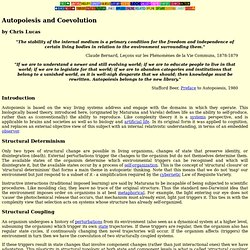
"Claude Bernard, Leçons sur les Phénomènes de la Vie Communs, 1878-1879 "If we are to understand a newer and still evolving world; if we are to educate people to live in that world; if we are to legislate for that world; if we are to abandon categories and institutions that belong to a vanished world, as it is well-nigh desparate that we should; then knowledge must be rewritten. Autopoiesis belongs to the new library. " International Society for the Systems Sciences. The International Society for the Systems Sciences (ISSS) is among the first and oldest organizations devoted to interdisciplinary inquiry into the nature of complex systems, and remains perhaps the most broadly inclusive.
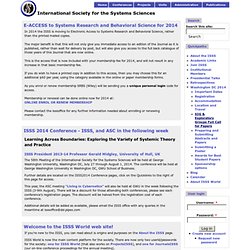
The Society was initially conceived in 1954 at the Stanford Center for Advanced Study in the Behavioral Sciences by Ludwig von Bertalanffy, Kenneth Boulding, Ralph Gerard, and Anatol Rapoport. In collaboration with James Grier Miller, it was formally established as an affiliate of the American Association for the Advancement of Science in 1956. Originally founded as the Society for General Systems Research, the society adopted its current name in 1988 to reflect its broadening scope.
List of systems sciences organizations. European Journal of Information Systems. Chapter 1 – Introduction — Jonathan Gabbai. Think of an ant – tiny and rather insignificant on its own.
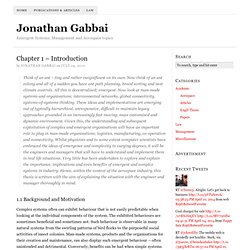
Now think of an ant colony and all of a sudden you have ant path planning, brood sorting and nest climate controls. All this is decentralised; emergent. Now look at man-made systems and organisations; interconnected networks, global connectivity, systems-of-systems thinking. These ideas and implementations are emerging out of typically hierarchical, unresponsive, difficult to maintain legacy approaches grounded in an increasingly fast moving, mass customised and dynamic environment. Information Systems Journal. The_unwritten_laws_of_business_HD.jpeg (Image JPEG, 1947x2035 pixels) - Redimensionnée (38%)